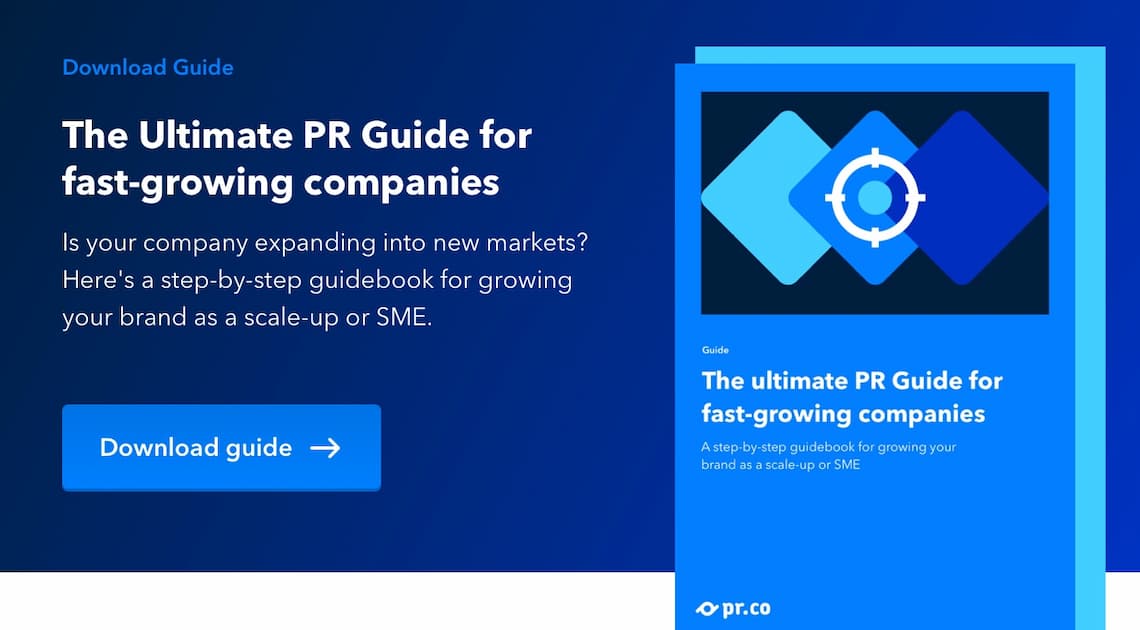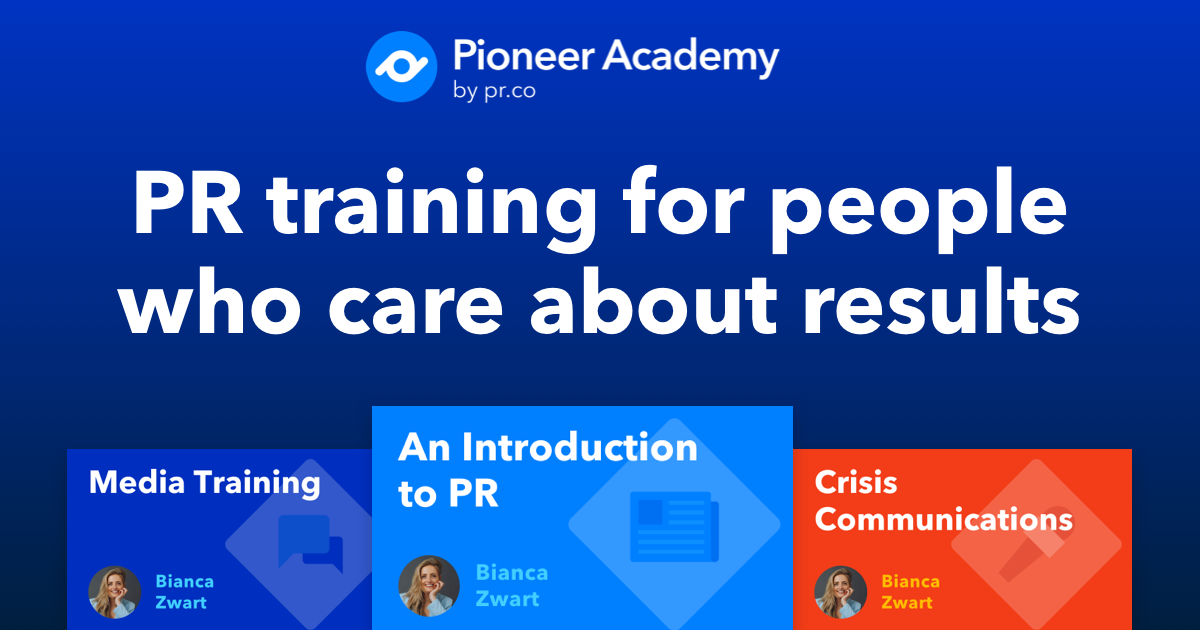No one starts a successful business with the ultimate goal of getting rich. Surely, you’re thinking, ‘what about Theranos' founder Elizabeth Holmes? Or the crypto queen herself, Ruja Ignatova?'Just look at where greed got them: on the FBI’s most wanted list of fugitives or convicted for criminal fraud.
Powerful business ideas stem from a deep desire to solve big problems. This can be ridding our oceans of plastic waste, giving billions access to clean drinking water, or helping doctors, teachers and nurses get rid of all that bureaucracy. Great business ideas come from a passion.
Our role as communicators is to share this passion with a huge group of people with whom this resonates.
If you’re reading this, you and your company have probably figured out how to communicate your mission. Your business is growing, and it’s growing fast. You've found resonance– now it’s time to enter new markets, and figure out how to resonate with them too.
Expanding your PR strategy to new, unknown countries is a proper challenge. But it’s also wildly exciting. And it's absolutely crucial for your company’s success.
You can’t lean blindly on paid advertising, content marketing, and other ways of lead generation. To grow sustainably, you need a strong brand, a good story, and a solid reputation. You need PR.
This guide will shed light on everything you need to take your PR strategy to the next level. We spoke to dozens of PR pros at fast-growing, disruptive brands to document what they learned when their brand started growing.
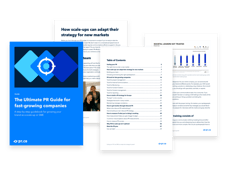
Download the Guide
Want to save this guide for later?
We use your contact information only to contact you about our products and services.
We never pass your information on to third parties. You can easily unsubscribe anytime.
Table of Contents
-
Scaling your PR strategy
-
How scale-ups can adapt their strategy for new markets
-
PR tools for fast-growing companies
-
How to build a PR strategy when entering Europe
-
How to get traction through inbound PR
-
How to measure if what you're doing is working
-
Why PR for scale-ups isn't optional
-
Meet the PR pros
Scaling your PR strategy
There’s no straight answer for when you should start scaling your PR efforts. It really comes down to your business objectives, strategy, and capacity to expand.
However, the right timing is essential. You don’t want to scale too quickly or recklessly and create organizational problems that are hard to undo. When you grow too fast and customers start complaining, you won’t know what hit you when the bad reviews start rolling in.
You also don’t want to be slow and miss out on key opportunities. So when’s a good time to grow your PR strategy to new markets?
“Launching your brand in a new market is no easy feat. Before scaling our efforts, we analyze if we are ready to start engaging with journalists, answer their queries, and sustain PR efforts in the long run. We won’t go all out with PR unless we are confident that we can achieve our goals through specific tactics.”
- Fiola Foley, Director of Media Relations, Komoot
-d971c5-original-1583249562%20(1).jpg?width=1140&name=348557-393A6813WTSHNN%233%20Credits%20@maas.rides%20(1)-d971c5-original-1583249562%20(1).jpg) ▲ Komoot has become the outdoor app of choice for over 18 Million people worldwide. Headquartered in Potsdam, Germany, komoot is home to the largest digital community of outdoor experts in Europe.
▲ Komoot has become the outdoor app of choice for over 18 Million people worldwide. Headquartered in Potsdam, Germany, komoot is home to the largest digital community of outdoor experts in Europe.
The right time to enter a new market
Before dipping your toes in a new market, you must first test the waters. You must take the temperature of the location you are entering. This starts by conducting good research and social listening to understand how your industry works abroad. If the concept of your business is widely known in the new market your new market, breaking into the industry will be fairly easy, despite the competition.
On the other hand, if your product or service is less accepted or well-known, you must lay the groundwork first. Before introducing your brand to the new market, you first have to get the conversation going. In the beginning, your messaging shouldn’t be focused on your brand, per se. Instead, the conversation should revolve around the problems that your target audience experiences and how you actively try to solve them. This approach builds trust with gatekeepers and thought leaders so they can validate your product or service further down the line.
If you’re lucky, the decision of when to enter new markets will be dictated by the demand for your product or service. Take Komoot as an example. Komoot is a route planning and navigation app, home to the largest digital community of outdoor enthusiasts in Europe. The app was first launched in Germany. A few months later, Komoot began to notice an increase of users in the Netherlands using their app not just for cycling, but also for hiking. This led them to believe there was potential in this new market. Komoot proceeded to hire a community manager and partner up with a PR agency for their launch in the Netherlands.
How scale-ups can adapt their strategy for new markets
Before you burn through your PR budget, it’s important to analyze if you’re ready to take the leap. Start by asking yourself: are we ready? We don’t mean it in a motivational speech kind of way. Launching a product in a new market requires communications efforts to support it. Are you ready to engage with journalists in that region? Do you have the right spokesperson to interact with the media? Do you have the capacity to sustain PR efforts in the long run, way after you’ve launched? Devoting the right resources to your ambitions is the key to success.
Building your team
Once you have a basic idea of what expanding will look like for your business, the second step consists of mapping out who will be by your side when you start growing. You can either build an in-house team or hire an agency. The best option? The answer is… drumroll please… it depends. There are tons of pros and cons for both strategies – but ultimately, the decision comes down to what works best for your organization and budget.
Torn between hiring new team members or partnering up with an agency? Here are some advantages for each strategy that might help you make a decision:
Advantages of hiring an in-house PR team:
- Proximity and speed: Keeping PR in-house means having a dedicated team, to which you are the sole client, located in the cubicle next to you or on the floor below. This proximity, not only in the physical sense but figuratively as well, allows your actions to be quicker.
- Culture fit: No one knows your market, your product, and understands your people better than you. Investing in a team of PR pros can guarantee your ideas won’t get lost in translation because they are born from within the team.
- Adaptability: An in-house PR team allows a high level of adaptability. They can easily rearrange task priorities, implement changes quicker, and adjust your strategy to your budget allocation.
Advantages of hiring a PR agency:
- Expertise: When you hire an agency, you count on a talented, specialized, and dedicated group of professionals to build and execute your PR strategy. With this, you gain access to more senior experts that have accumulated experience in different industries by working with various clients.
- Manpower: Outsourcing your PR means leveraging the strength of not one, not two, but a handful of talented professionals. Essentially, this allows you to delegate tasks and explore new ways of connecting through PR without hiring new employees.
- More PR opportunities: Chances are that, to a PR agency, you won’t be the sole client. Sharing an external PR team with other brands means you have a higher chance of connecting with a broader network. In this case, your agency serves as an ally, a connector that can help you find new partnerships, possible investors, and new business opportunities amongst the people they already know.
.jpg?width=1000&name=DTS_new_studio_Misc_5606%20(1).jpg)
Here are other considerations to take into account when deciding how your team will grow.
Whichever route you decide to take, we suggest taking small, strategic steps. Add resources, or team members, only where necessary, and don’t burn bridges along the way. Keep your strategy as flexible as possible, making space for corrections and learnings as you go.
Choosing and training the right spokesperson
There’s an overused quote out there by Benjamin Franklin:
“It takes many good deeds to build a good reputation, and only one bad one to lose it.”
Cliché? Sure. Relevant? Absolutely. If you’re growing fast, media attention often bursts in out of nowhere. If you handle these media requests with care, focus and expertise– it will catapult your brand into the big game. If you underestimate the importance of a skilled spokesperson– it might do the opposite.
Here’s how to pick the right spokesperson, or spokespeople, for your brand:
Who in my team makes a good spokesperson?
Usually, fast-growing companies tend to delegate PR tasks to their on-site teams. This means that those handling media queries and speaking on behalf of the company are salespeople. This might not be the best way to win journalists over. Salespeople are very commercially focused – too salesy, if you will. So are marketers. The way they talk about your company doesn’t resonate with journalists. The more relatable you are, the more interesting your story becomes.
One look at the Edelman Trust Barometer will tell you that people don’t believe in CEOs or governmental leaders. Who do people rely on to tell them the truth? Unsurprisingly, it’s scientific experts and those in close proximity, like coworkers, for example. This shows that a spokesperson doesn’t necessarily have to be a CEO or a C-level executive.
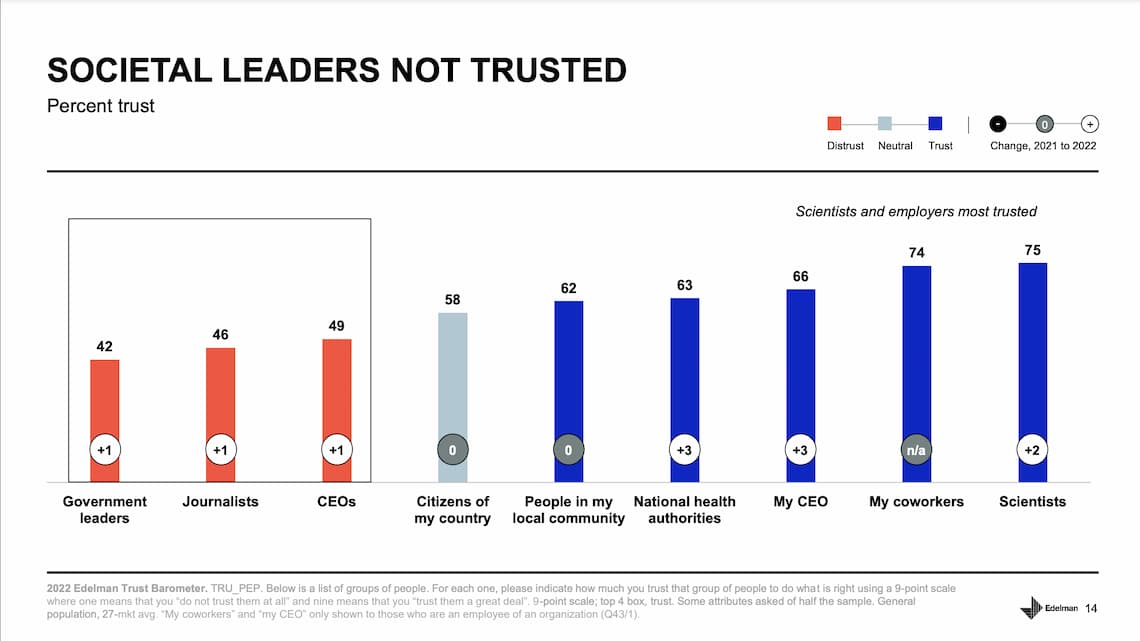
▲ The 2022 Edelman Trust Barometer reveals that scientists along with coworkers are the most trusted groups, while government leaders, journalists and CEOs are the least trusted groups.
You don’t have to pick just one spokesperson for your entire company, you can (and should) pick different people to represent your brand at different points. For example, your CEO would be your best pick when you are launching a product or celebrating a big milestone. But to build thought leadership in your industry, you should go with specialists, scientists, or experts.
In the case of a crisis, pick someone from your communications team. As a consumer, if you witness a brand catching fire, you wouldn’t be keen on seeing a CEO talking to the media all the time. You would rather know they are working on fixing a problem and letting the communications team handle any questions.
Anyone can be the right spokesperson with the proper training. For starters, your spokespeople must be fully aligned with your company’s narrative and which key messages you would like to highlight. They must also lend time to prepare for interviews with the media and grasp what the media landscape looks like.
What spokesperson training consists of
Spokesperson training implies honing your communication skills by investing time and effort into researching what the media expects from you and rehearsing how to deliver that. Over the years, media training has become more and more complex. Not only do spokespeople have to prepare for formal sit-down interviews with the media, but also have to be ready for any interaction they might have. This includes podcast interviews, speeches at universities, conversations with investors, and even social media comments.
Basic media training consists of understanding how the media works in the specific media landscape, what they are usually interested in getting out of an interview, and how you can prepare to answer.
Two tips to become a more efficient spokesperson
Be authentic
No matter how strong your bond is with journalists, the ultimate goal of journalism is to break the news – so you might not get a say in how your brand is portrayed. This is where media training comes in.
There are some tested and tried ways to respond to challenging questions in interviews. For example, you can use the ABCD strategy which stands for Answer, Bridge, Control, Dangle. You answer the question you receive, then you bridge toward the topic that you want to speak about so you have control over your narrative, and when that question is answered, you can dangle a new topic, fact, or angle that might be interesting to the journalist and their audience.
Here’s how to answer difficult questions from journalists.
However, we want to highlight that PR today is less about being confrontational with the media, but sitting at the same table as journalists and collaborating with them to create powerful, honest stories. An efficient spokesperson is one who is genuinely interested in sharing the truth, no matter how ugly it can be. Human connection is formed through shared vulnerability, so don’t be afraid of being authentic.
“I’m not a big believer in tips and tricks for media training. When I started out in the industry 20 years ago, PR professionals were known as spin doctors or fixers. That's absolutely not the case anymore. In all honesty, I think that our job is to help organizations be the best versions of themselves and tell a more honest story.”
-Jody Koehler, co-founder of CooPR
Build a personal brand
Your spokespeople are the face and voice of your brand. Customers, investors, the government, and local communities are listening in on what your spokespeople have to say on social media, at events, blogs, as well as on formal channels like sit-down interviews with the press.
Use every channel to your advantage: write think pieces on your LinkedIn profile, comment on news via Twitter, and share your life story on a podcast. Each channel represents an opportunity to create a personal narrative for your spokespeople, which can give your brand’s messaging more power and authenticity.
-jpg.jpeg?width=1140&name=414732-Ali1-ce8c94-original-1642508824%20(1)-jpg.jpeg) ▲ Ali Nikman is the founder and CEO of bunq, a fintech platform revolutionizing the banking industry.
▲ Ali Nikman is the founder and CEO of bunq, a fintech platform revolutionizing the banking industry.
Take bunq’s CEO as an example. Bunq is a fintech platform that is revolutionizing the banking industry. It was founded in 2012 when founder and CEO Ali Nikman set out to radically change the way people handle their money.
Nikman isn’t a banker himself, he is a programmer and serial entrepreneur. His personal story heavily influenced bunq’s development. Because so many of the early contributors to the platform came from an IT background, the bank has been frequently labeled “an IT company with a banking license”. Beyond the product and services, this personal story shapes a brand’s message and sets bunq apart from its competitors.
Remember, human beings like to buy from human beings, not from fantasies or robots. Find a story that resonates and build up on it.
How spokespeople can expand your reach
Spokespeople generally gain visibility during a crisis. They are the ones putting out the fires or facilitating the dialogue between communities and the company. However, you shouldn’t wait for a crisis to make the most of your spokespeople’s profiles. Here’s how spokespeople can help amplify your company’s story:
- Sharing industry insight: Fun fact: people don’t know what you work on, day in, day out. It might surprise you that the insight you’ve gathered over the years can be very useful for those outside the company and the industry. After all, if you are the spokesperson at a scale-up it means you are doing something groundbreaking. Never underestimate the knowledge you bear. Share it with others.
- Building relationships: PR isn’t a task solely delegated to a department at your company. Your spokesperson should also actively build relationships with important stakeholders like local politicians, media contacts, and investors. Invite them into your company, have coffee with them, and offer your take on any piece they might be working on. Being helpful, kind, and authentic goes a long way.
- Volunteering: Offer your voice (and face) at local events and universities. Lend your time to students that are just starting out. Become a mentor. Getting involved is low-hanging fruit that can help you build relationships with the local community, increasing your stakeholder’s trust.
- Being as visible as possible: There’s no use in doing any of the above if no one can reach you. Your contact information (name, number, email address, and social media) should be easily found with a quick Google search or in your brand’s online newsroom.
PR tools for fast-growing companies
Once you’ve figured out who will be on your team, you must equip them with the right tools to empower their work. Not only does automating tasks save you time, but it can also reduce human error, making your work a lot more efficient. The more your team relies on software to do the heavy lifting, the more time you have to focus on the bigger picture.
This section has compiled a list of online tools and software to help your team scale your PR efforts. Why take our advice? For starters, we don’t have partnerships with the tools listed; we just know they’re excellent. And how do we know this? Over the last 10 years, we’ve spoken to dozens of successful PR teams at some of the most exciting and fastest-growing companies out there. They’ve shared the tools that make their jobs more manageable, and now, we’re passing them on to you.
If you’re looking for more online tools to make your work more efficient, check out our complete guide on PR software for 2022.
Tools for project management
A good project management tool makes planning, executing, and monitoring project progress a total breeze. These tools create a transparent record so that everyone knows who is doing what and when. This is especially important in a scale-up, given that teams are growing quickly. By setting clear expectations and defining roles and tasks, your work will benefit from choosing the best project management tool for your team.
Trello:
A kanban-style project management tool to track your ‘to-dos’ and virtually everything else.
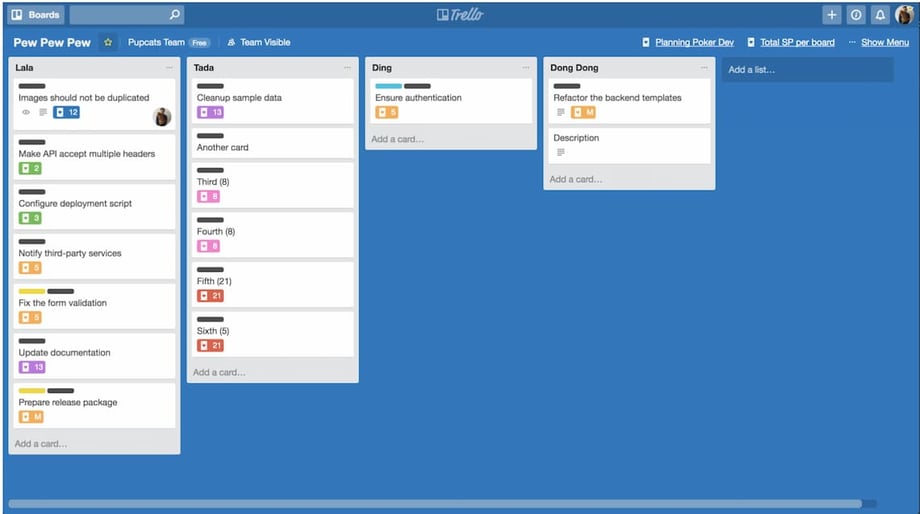
A classic, and for a very good reason. Trello is a visual collaboration tool that helps your team visualize projects with satisfying clarity. It’s great for all types of teams, from sales and marketing, to HR and operations, and even PR. Trello allows you to manage projects, organize tasks and track success – all in one place. Teams can customize their workflows by adding task assignments, timelines, productivity metrics, calendars, and much more. Plus, with over 100+ integrations with other key tools like Google Drive, Slack, and Jira, Trello is the perfect tool for distributed PR teams.
Miro:
The online whiteboard platform that helps you co-create and bring meetings to life.
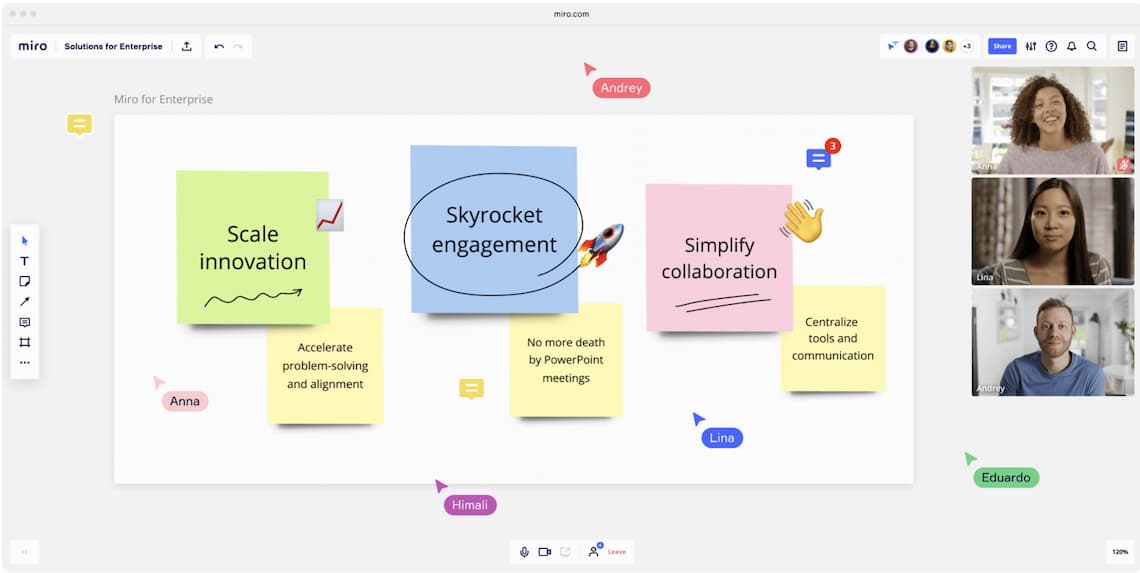
If your company is growing quickly, you’ll want to add Miro to your tool stack. This digital whiteboard has a host of features to visualize projects, whatever the device. Think nice visual landscapes complete with post-it notes, annotations, and graphs so you can visualize your customer journeys, sprint planning, retros, and more. Like Trello, it integrates with most enterprise tools, making it easy to fit into your workflow. What strikes us most about Miro is that it’s so well designed. It looks beautiful, works perfectly, and includes features you didn’t even know you needed. It’s also worth mentioning Miro themselves have gone through a growth spurt over the past couple of years. They are currently valued at $17.5 billion, with more than 30 million users, and counts nearly all of the Fortune 100 companies as clients. Pretty impressive, right?
The only cons are that it can be a little heavy on your CPU, but using their app solved this issue for us.
Basecamp:
An online project management and collaboration tool for hybrid and remote teams.
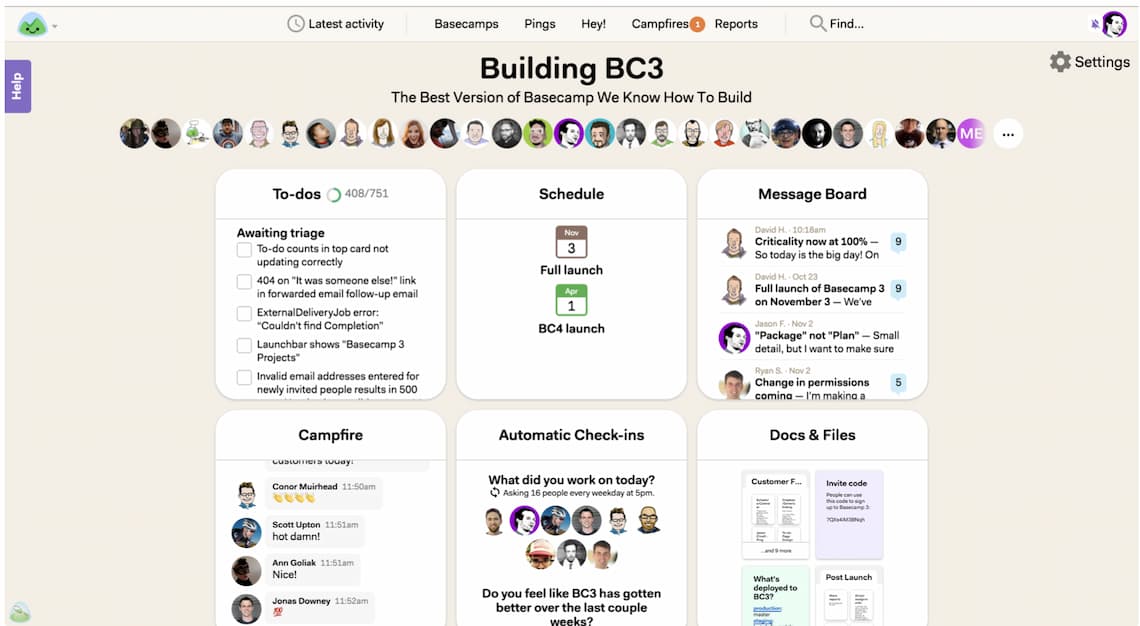
Basecamp has been a remote company for 20 years. Now, that is a company you trust to build a good project management tool, right? Basecamp’s ‘all-in-one’ project management platform can save you the busywork of patching together different tools. While Basecamp doesn’t do it all, it does a great deal and solves a common problem of accountability and delegation for communications teams. In this ‘virtual office,’ you can chat, create to-do lists, post files and documents, keep track of schedules and meetings, etc. It’s beautifully designed and has famously good support. The only cons are that it’s not easily customizable, and different versions have different features.
The folks at Basecamp are true innovators. A nice example of that is how they have entirely removed the online/offline status of employees in their app. Their reasoning: “Who cares if your colleagues are online all the time? Let them walk the dog, do the laundry or get a cup of coffee. A good company doesn’t care about its employees being online all the time– who cares if they’re getting their work done?”
Tools for Internal Communications
One of the most common pitfalls for PR teams at scale-ups (and every other company) is the lack of communication between teammates. Ironic, isn’t it – that communicators have a hard time communicating? The only way to prevent this is to create channels that foster daily conversations.
Slack:
A messaging app for businesses.
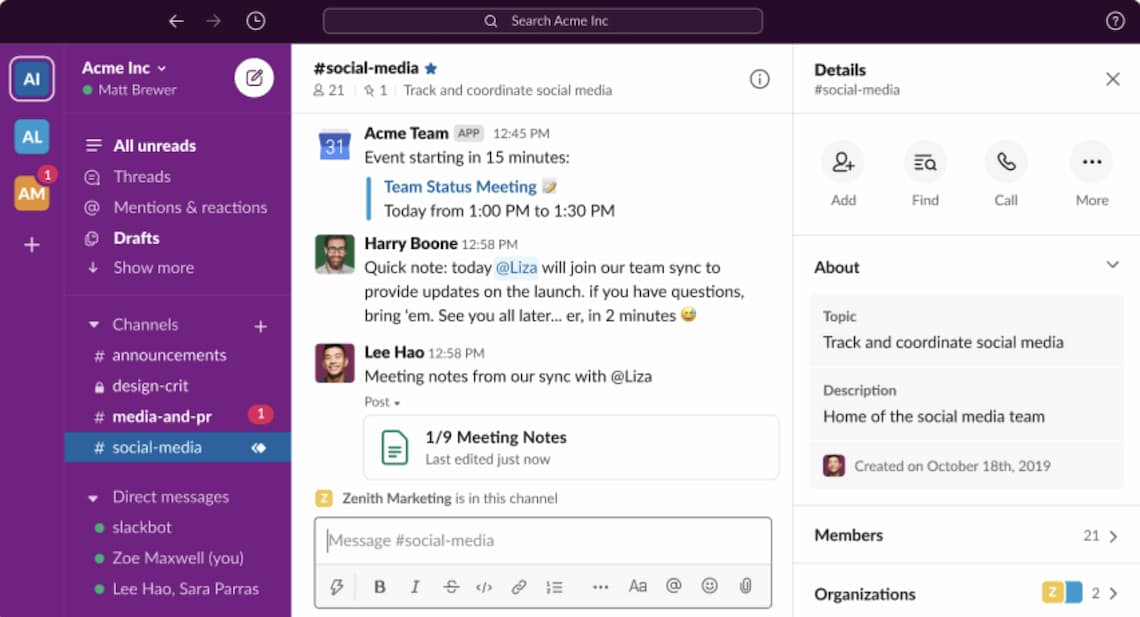
This is the backbone of our team. Slack makes communicating fun, but it keeps you up to date with what your colleagues are doing in seconds. With multiple channels, workspaces, and reply threads, private or public, it’s easy to organize discussions— you can even write messages to yourself to revisit later.
For us, the most powerful feature is probably Slack’s search function. It’s invaluable for finding missing information and drawing attention to past conversations.
Editing a message once it has been sent is also helpful for the trigger fingered amongst you. This tool is especially powerful when working with international agencies and partners, as it genuinely brings teams together.
Notion:
Your company's very own wiki.
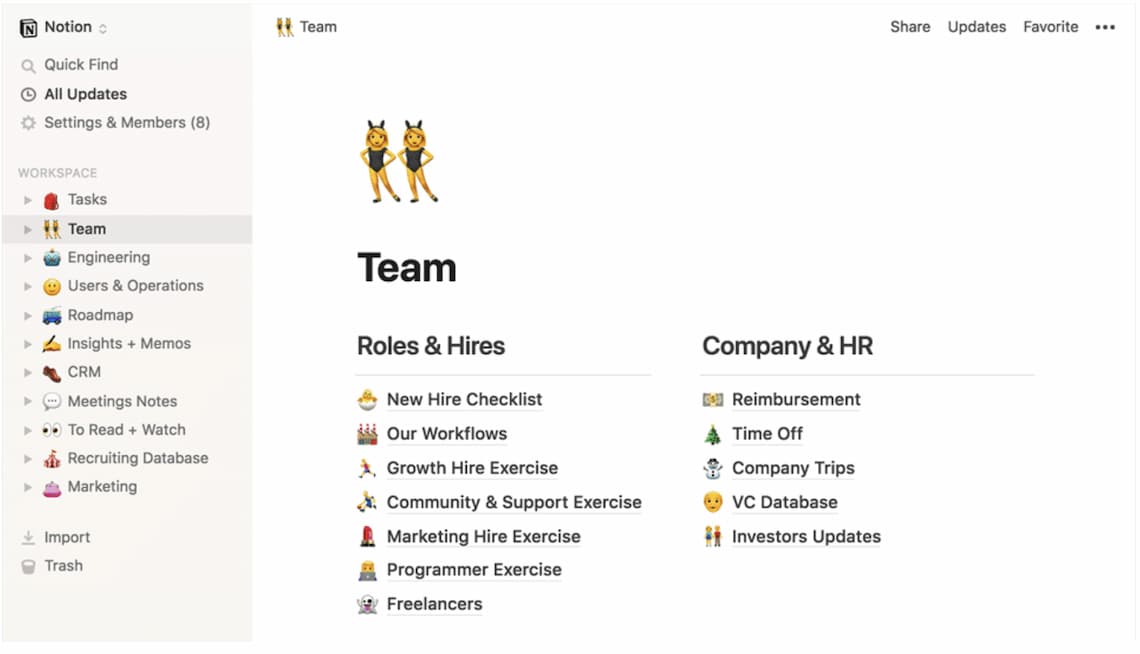
Growing a company means building processes. With Notion, you bring all these processes, strategies, protocols, and tutorials together, so that your team always knows where to find them. Like an internal wiki, you can store information in countless formats. With nice integrations with Google docs and reporting tools, it’s a brilliant hub for everything you are working on. When our team began to see how flexible the tool was and just how many tasks you could use it for (there is a notable learning curve), it became a staple. Notion will help your team get organized and will definitely aid your onboarding process.
Tools for Monitoring
Before dipping your toes in a new market, it’s essential to feel the room. Especially since you’re growing your company and targeting new audiences. When you have a handle on how you (and your competition) are being covered, it’s easier to spot opportunities and chart a course. Likewise, knowing how your customers and employees view your brand is crucial so you can create a language to reach them.
Monitoring the landscape will also help you anticipate crises. The research you do will be great for SEO and increasing traffic. The tools below can help you with keyword research, website optimization, and backlink strategy.
Agility PR
Helping PR pros generate and monitor media coverage, measure results, and demonstrate their value.
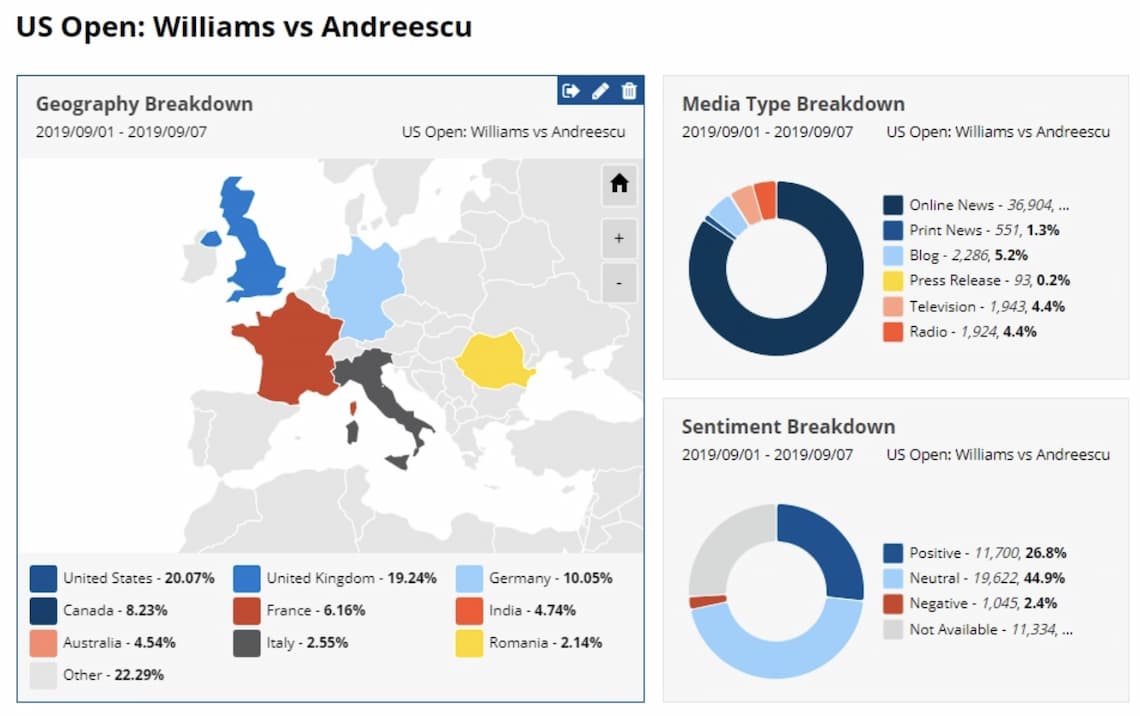
Agility PR is our favorite tool to monitor media coverage and report results with user-centric features. For starters, you can search a wide range of industries. Moreover, it can be a valuable tool for staying on top of industry developments. The search is flexible, and the results are reliable. Customer service is generally good.
Meltwater
A powerful tool for brand management
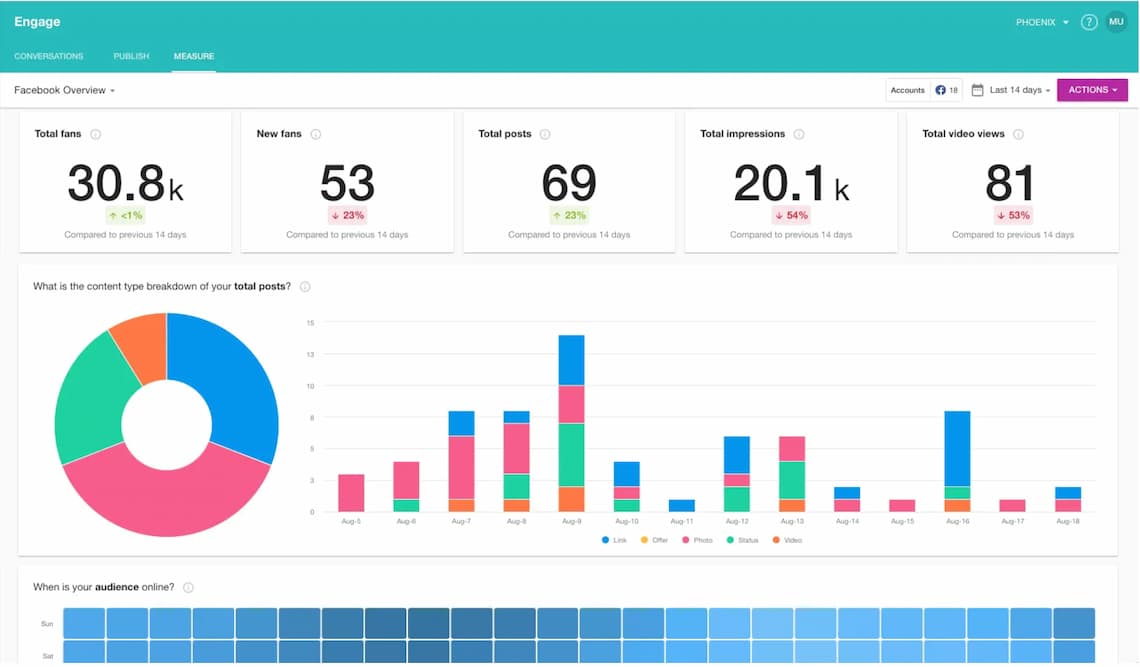
Meltwater helps PR and marketing teams monitor media coverage across both news and social media and enhance brand management.
Taking the temperature of any market before entering is a must. One tool that will help you do some social listening and media monitoring is Meltwater. This tool even adds a layer of reporting which gives you precise data and insight into how your brand is perceived. Meltwater is a little pricey, and their sales agents are pushy. If you can put up with this, their media monitoring tool is good. Many PR pros we’ve spoken to have recommended Meltwater as their favorite monitoring tool.
LexisNexis NewsDesk:
A tool to search, analyze and monitor media intelligence
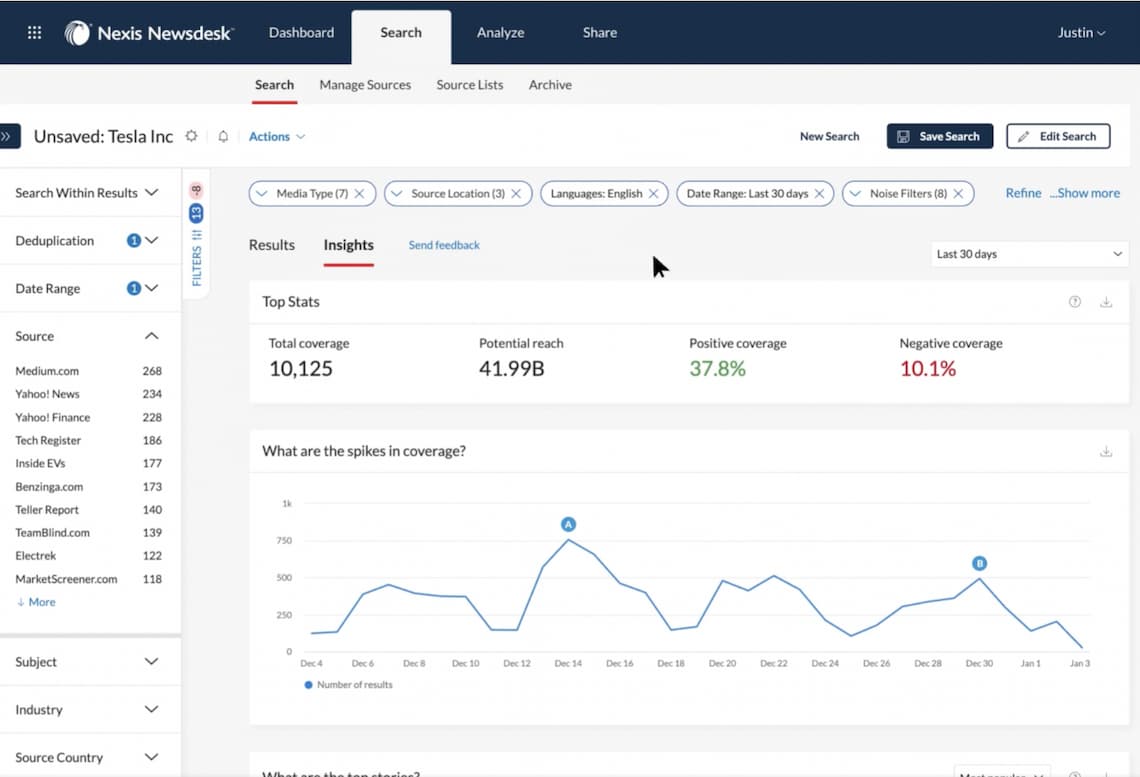
Simple to set up, LexisNexis' NewsDesk is an excellent resource for media research and spotting trends. Most importantly, LexisNexis is the platform for offline media. Interestingly, this is where all the other monitoring providers get their offline media monitoring data. It’s reliable and well organized: especially if you’re a visual person.
Mention:
Web and social monitoring, for a fair price.
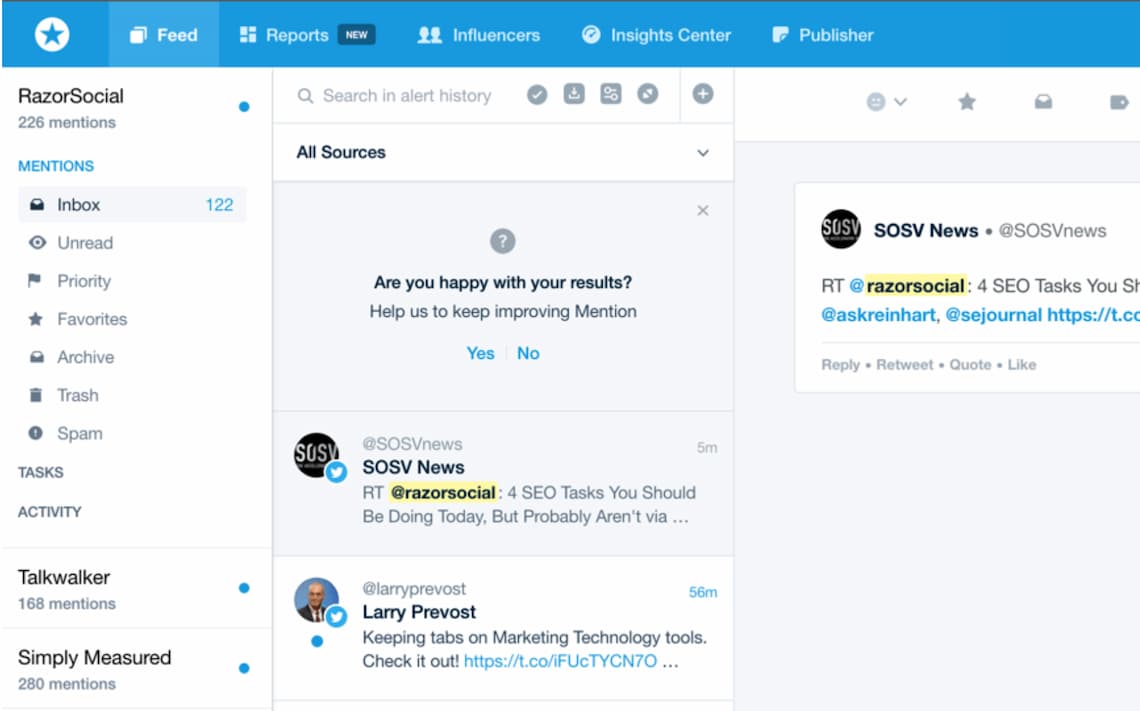
A bad review can hang around like a ghost, impacting your reputation for years to come. Social listening tools allow you to keep on top of the conversation and respond within time.
If you want a handle on how people feel about your brand, Mention is the tool for you. The interface is clean and customizable, and you can easily download data in an Excel sheet if that’s your bag. It’s cost-effective, picks up details quickly, and can be set up in less than an hour so you can get back to work. Make sure you set up suitable filters, or you may be flooded with information from social media, news, message boards, and forums. If you want to add traditional media like TV and Radio, you will need to pay quite a bit extra, which might not make sense for a startup, but might come in handy if you’re in hypergrowth.
Tools for Content Creation
Much logistical legwork goes into the ‘creation’ part of content. You probably want to eliminate this to get back to the fun part: telling great stories. But without great packaging, your message will be lost, which is why quality content is so important. These tools will help you whip up something of quality in minutes.
Grammarly:
A typing assistant that reviews spelling, grammar, punctuation, clarity, engagement, and delivery mistakes.
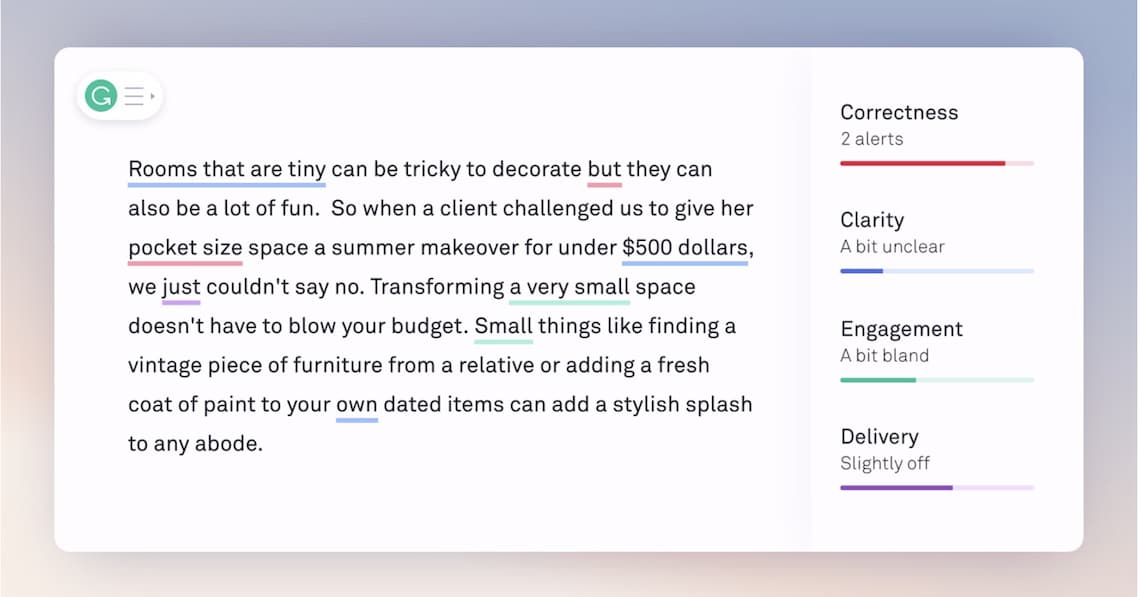
There’s nothing worse than spotting a typo or grammar mistake after the fact. Grammarly is bound to up the quality of every comms department. It helps you identify ugly sentences, refine tone, avoid errors, and give a nice explanation for each suggestion. If you write content for legal documents or press releases, catching those errors that slip past the human eye will do wonders for your credibility. Our (tiny) bugbear is that dismissed notifications can mysteriously reappear.
There's a lot more where that came from. Here are 30+ online resources that will help you become a better writer.
Canva:
A graphic design platform that helps you design anything from logos and social media content to documents, prints, and more.
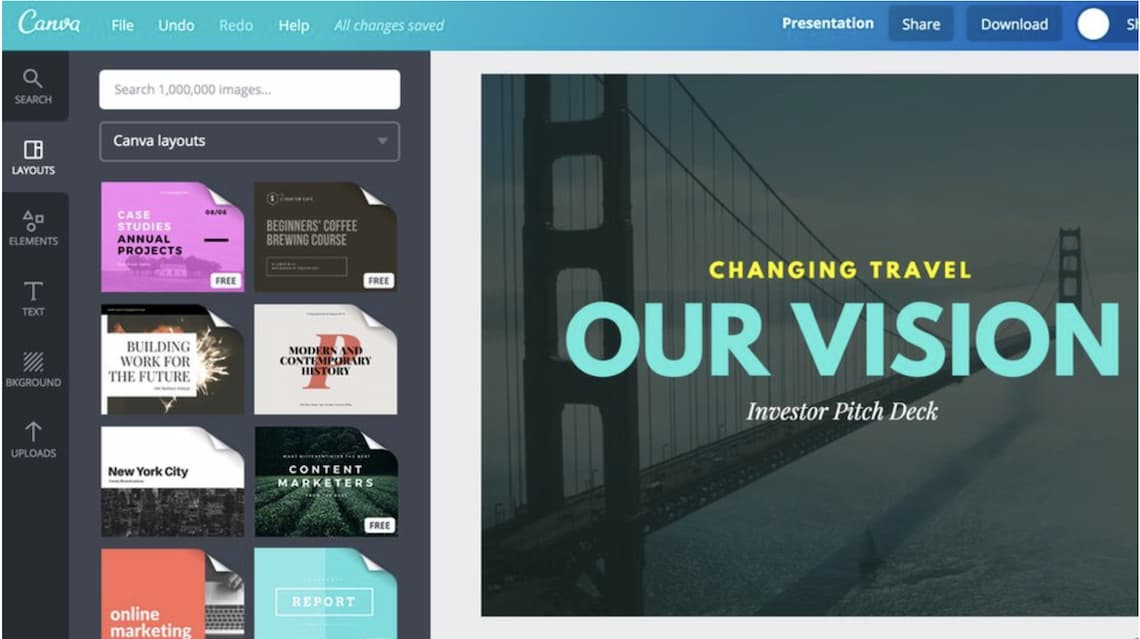
Sure, your graphic designer might disagree (they’ll prefer the Adobe Suite), but Canva is a great tool to help you get the task done quickly. While we love the Adobe suite, most of us do not have the time to master it. Luckily Canva exists, which helps you create a social media graphic or improve a photo with very little expertise. With plenty of templates for visual assets and easy drag and drop functions, you have quite a lot available on the free plan— although the stock photos are a little on the cheesy side. We would suggest sourcing your own.
Soapbox by Wistia:
A tool to record, edit, and share videos.
If you’re onboarding agencies abroad, you’ll want to check out Soapbox. This tool is perfect for tutorials or talking head videos. All you need is a Chrome extension and a webcam. Soapbox is easy-to-use, and the end result looks well edited without feeling too staged. Videos are done in one take, so you must be camera ready.
▲ Here's our colleague Sjors giving an overview of our product using Soapbox.
Tools for Content management
Every Saas advert will talk about saving you time— with good reason, time is the most valuable commodity. Nevertheless, we’ve heard it so often that our eyes start to glaze over even if it’s true.
If you work in PR, there is one tool that will genuinely give you back hours of your life. And that’s an online newsroom. Back and forth emails requesting info, sending out dozens of WeTransfer links, even pitching itself, all these tasks (mostly) disappear with an online newsroom.
This is why it’s getting a star position in this guide— because online newsrooms are one of the best tools to have in your PR arsenal. With a good online newsroom, journalists will have everything they could possibly need to write a story about you.
Maintaining a good reputation will require constant storytelling from your PR team. If you can tell those stories from a place that’s beautiful, packed full of info, and easy to use, your stories are simply more appealing.
Moreover, your news needs to be found to be picked up in the first place. A good newsroom is consistently at the top of search engine results pages. We should know— we work continuously to keep them there.
pr.co
A beautiful, branded newsroom boosts your brand credibility and significantly increases your inbound PR (journalists approaching you for a story). Our newsrooms are optimized to appear at the top of the Google results, so it’s findable in seconds. Designed in collaboration with journalists, pr.co newsrooms give them everything they need (high-res photos, contact details, quotes, clippings) in a few clicks. With strategically placed CTAs, you will convert incoming press traffic into long-lasting media relationships.
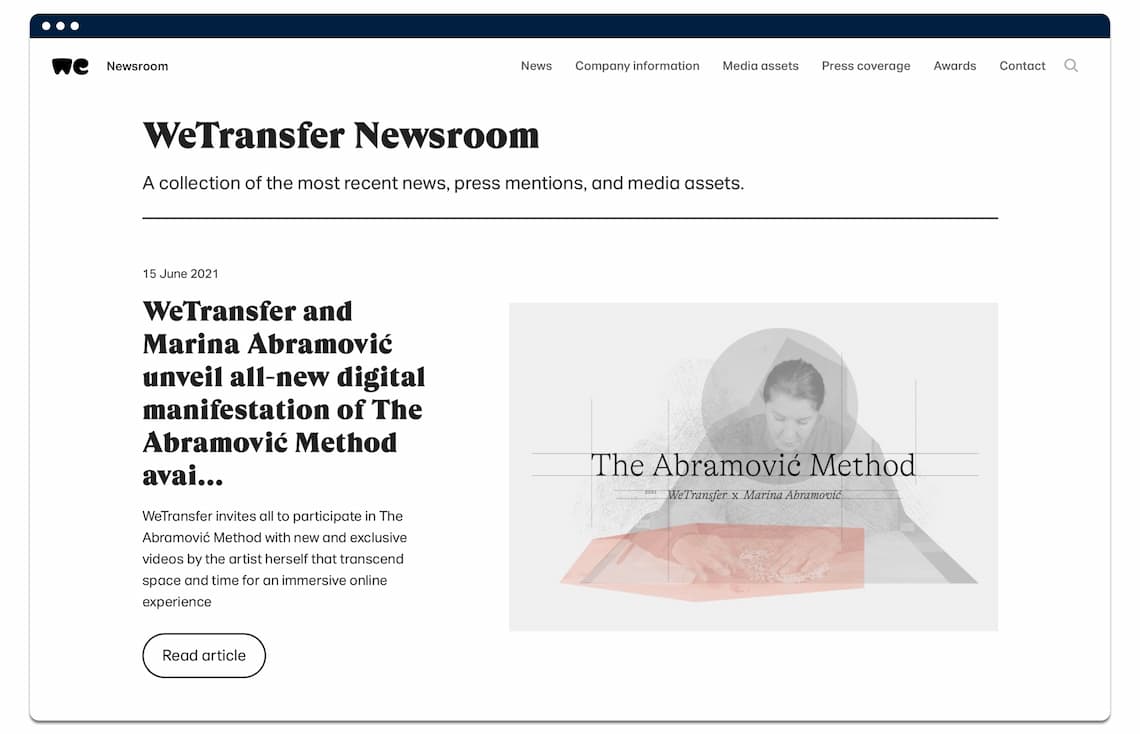
PR software (CMS and CRM)
Behind these newsrooms is straightforward content management software that makes it easy to collaborate with colleagues, wherever they are. Create media-rich releases, manage approvals, and set embargoes from one straightforward tool.
The smart email tool remembers every detail— from email history to open rates to notes about their dog— so you don’t have to. Create targeted press lists, timed emails, and smart filters, and watch your reply rate improve.
Here's what our clients had to say about our product:
"pr.co-launched our first newsroom four years ago. Since then, VanMoof has grown fast. Without fail, the pr.co team kept pace with us, re-designing our newsroom to our exact –and ever-changing– needs, building localized interfaces for our top five markets. What I appreciate the most is that the PR.co team has been there to help anytime we need them. All in all, pr.co has been key to our success in bringing our PR efforts in-house and enabling us to cater to a growing audience of press from worldwide."
-Karlijn Marchildon. Head of Communications & PR at VanMoof.
“Our first newsroom allowed us to communicate with stakeholders in English, but now we’re expanding to other countries. We work with agencies across Europe and use separate newsrooms to communicate to each individual market, in their own language, with news pertaining to that region. All of this while trying to serve a journalist in the best way possible.”
-Kajsa Apelqvist, PR & Communications Specialist at Lynk & Co
“I would highly recommend using a pr.co newsroom. It is an excellent tool to have, especially just to keep things organized. We just don’t have the capacity to build or manage a newsroom ourselves. Because it’s a living thing, we’re constantly adding to it and changing it. Having a tool like this to support your efforts and have a nice professional presence for the media is super important. Because let’s face it, you’ll never be able to hire enough PR people to build and manage a newsroom at this phase of a company.”
- Christa Connell, Head of Public Relations at BUX.
Disclaimer: As a PR software company, we (unsurprisingly) don’t have access to or first-hand experience of our competitors’ software. We only want to recommend tools that we either use personally or are used by most of the comms departments we work with.
It would be insincere of us to make an assessment of a product we have never used. But based on the glowing feedback we get from our customers, we are confident that we are the best solution out there — we’d be willing to stake a great deal on it.
Tools for reporting
Your CMO will probably get stricter with results now that your company has grown. Despite your best efforts, there will always be someone somewhere demanding a pie chart. These tools prove you’re producing bang for your buck.
Coveragebook:
A tool to help PR professionals & agencies showcase and measure the impact of their earned media.
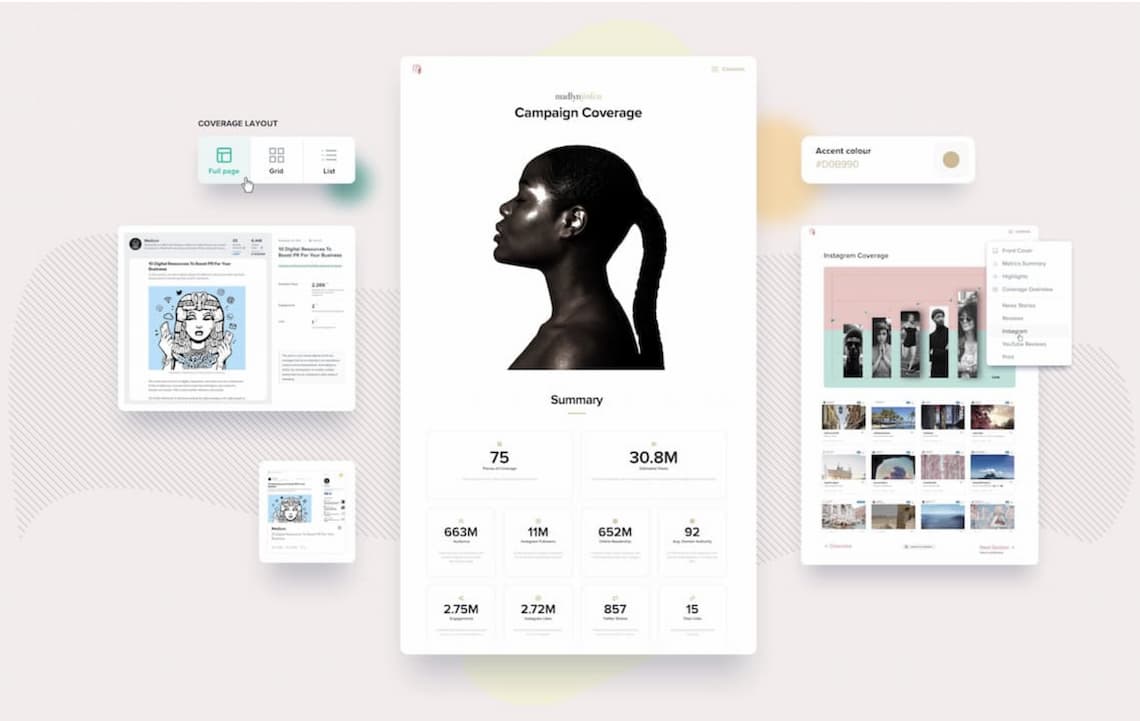
A great way to brief a new agency you’ll be working with is by providing your previous coverage. Putting together a coverage book to show off your hard-earned media can require some blood, sweat, and tears. Thankfully there is software that can take care of that for you. CoverageBook is a straightforward tool can produce professional-looking reports with just a link. It includes a Chrome extension to easily bookmark links to add to reports at a later date. You can sort information in a variety of formats, and the support team is great.
Google Analytics:
An analytics platform that helps businesses gain marketing insights and more.
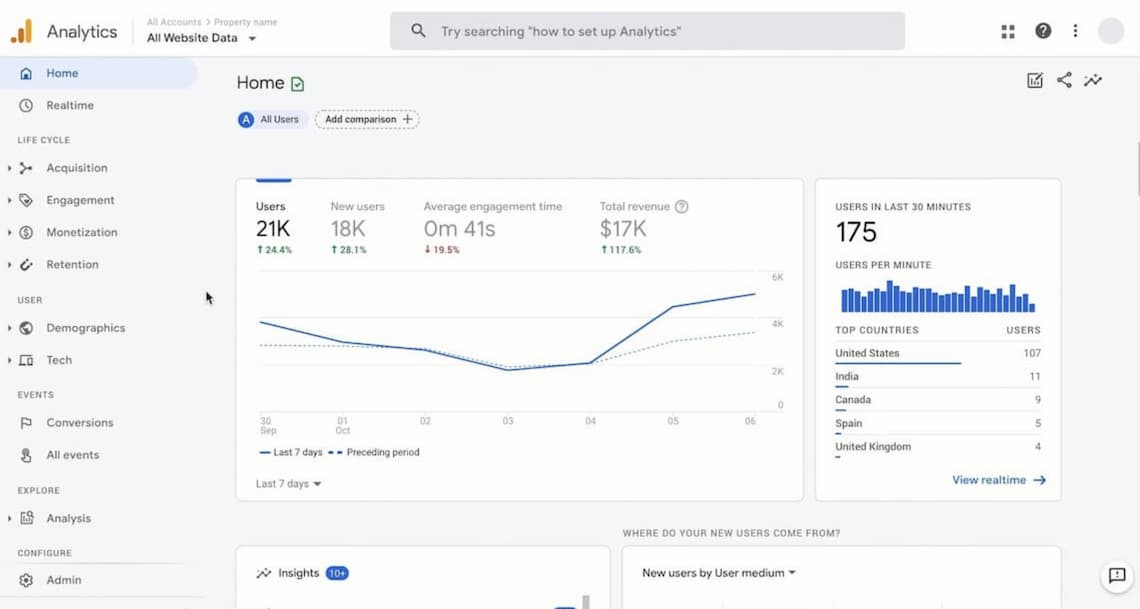
The array of things you can measure with Google Analytics is mind-boggling. As a result, it can be a little intimidating for a first-timer, but once you have control of the basics, you’ll have a good insight into your users’ behaviors and content performance. Plus, it’s free.
Choosing the right tool stack for your team
Scalability is a mindset. It's all about having the systems and people in place to make your growth as seamless as possible. The difference between handling public relations in a startup and a scale-up lies in the professionalization of processes.
Once your brand has started picking up traction and is expanding, it's important to put it all on paper. Christa Connell, Head of Public Relations at BUX, suggests you get organized before the next growth spurt: “Find the right tools for your team, put together a proper strategy, and align your goals with the wider growth team. You have to have all of your ducks in a row because things can change quickly.”
Here are some more elements to consider as you prepare to scale your startup:
- One step at a time: when scaling, it’s essential to be strategic with your decisions. Don’t spend money on hiring new people or software for that matter, until you’re absolutely ready to do so.
- Be mindful: there’s nothing wrong with staying small and lean if your product or service demands it. Grow only when necessary.
How to build a PR strategy for Europe
You’ve got your team structured and the right tools to empower their work – now it’s time to move on to the strategy. If your company is expanding into new markets, one of the most important considerations to be mindful of is how you adapt your PR strategy. The success of a PR strategy lies in localizing your messages to fit the market. Your message needs to resonate with your new audiences while maintaining your brand’s core message intact. This adaptation can be tricky, so we’ll share tips from seasoned PR pros below.
“PR is successful as it is relevant. The second it's not relevant to the segment or the market, it's just not going to work. To me, the term ‘globalization of PR’ is an oxymoron because PR always has to be local.”
Fiola Foley, Director of Media Relations, Komoot
“Europe” is not a country
Even though digital economies and globalization have made it easier than ever to expand to new markets, scaling still imposes an important challenge in terms of communications. Simply translating your message won’t cut it. This rings especially true in Europe. Don’t be fooled by the size of its markets, this continent is just as fragmented and different as any other.
It is a big mistake to believe that two countries have homogenous audiences because of their proximity and size. Just take Austria, Germany, and Switzerland as an example. Despite the fact that they all speak German, the audiences and media landscapes vary drastically across borders. The same goes with Flemish and Dutch– same language, but vast cultural differences. You must make those adjustments for each market depending on their culture and language.
Therefore, doing proper research on each culture, language preferences, and the media landscape in each market is a must. We’ve gone ahead and done a bit of that research for you. While the list is not exhaustive, we hope it gives you a glimpse into the differences in markets, cultures, and media landscapes in some European countries:
Jump to:
Here’s a more extensive list of European countries and their media landscapes.
How to enter the United Kingdom
Market
The UK market is widely known as a gate to global markets. Not only does the English language bridge the gap with other countries, but its long history of trade and its diversity also make it easier for international companies to succeed in the UK. Because of this, UK companies are open to working with international partners and multicultural environments. Therefore, this market seems friendly to outsiders and a relatively easy open.
While the startup scene thrives in the UK, it goes without saying that it’s also pretty crowded. Standing out can be tough when there are so many players in the industry. One of the most common struggles startups and scale-ups face is rising above the noise and grabbing the press’ attention.
Culture
The Brits have an unquestionable influence on the rest of the world. Just think of Prince Harry and Meghan Markle’s wedding which amassed a total of 1.9 billion viewers around the world. While the UK economy and business culture is open to foreign companies and cooperation, it’s safe to say that the British media (and Brits themselves) tend to be UK-centric. If you want your scale-up to get noticed, you have to have a local presence. This means either UK funding or UK customers. It also goes without saying that it’s crucial to have a native speaker in place that can speak to the media to answer any queries.
Speaking of spokesmanship (forgive the repetition), we recently sat down with the global spokesperson from one of the world’s biggest companies. Here’s what we learned about what it takes to be the face and voice of a brand.
.jpg?width=1140&name=swapfiets-scale%20(1).jpg)
▲ When in London, do as Londoners do. Here's an example of how Swapfiets, a Dutch-founded bike subscription service, adapted its messaging for its first-ever UK marketing campaign. Dubbed ‘On Yer Bike’, the creative campaign plays on Londoners’ transport frustrations, encouraging them to ditch public transport in favor of cycling.

▲ For the sake of comparison, check out how Swapfiets adapted its message in the streets of Brussels. The Belgian city is known for its love of comic strips – so much so that they’ve covered their walls with their favorite characters and authors. Swapfiets paid an homage to the city’s love for comics by copying its style for their ad.
Media landscape
The UK media landscape is strongly influenced by the mass circulation of national press and a system of public service broadcasting, led by the BBC. Although the press and broadcasting are organized nationally, regional and local media presence is still important, especially in Scotland, Wales, and Northern Ireland.
Like most countries, the readership of printed press has been steadily falling due to readers moving to digitally available news. According to Reuters, the circulation of print newspapers, which are still mainly distributed via newsstands, has declined on average by 10%. Meanwhile, the importance of television news increased during and after the pandemic, with the BBC, ITV, and Sky News all reporting an increase in weekly reach. The country is well adapted to digital media, with an impressive 95% internet penetration. It’s safe to say that the national press, in all its formats, is quite influential in the public sphere, particularly around election time.
How to enter Sweden
Market
The Swedish market is highly competitive, yet fairly open to foreign competitors. “They are not afraid of innovation and sustainability is a core focus for any type of company,” says Matias Rodsevich, founder of PR agency, PR Lab, a global PR agency specialized in fast-growing tech companies, which recently expanded to Sweden.
Compared to markets like the Netherlands or UK, Sweden is pretty small. Although Swedes have a high proficiency in English, you will mostly hear Swedish on the streets. Moreover, the absorption of web technologies and services is one of the highest in Europe and in the world. 99% of Swedish households have broadband access to the internet. So if you plan on entering the market and capturing consumers’ attention, reach the Swedish market online before you do so physically.
Culture
When it comes to succeeding in Sweden and getting yourself in the loop, you will need recommendations, intros, and references. Especially in the B2B sector. Matias explains, “Swedes prefer networking through introductions instead of meeting strangers. They like the exclusive aspect of events.”
Another thing you should keep in mind is the lack of titles. The work environment in Sweden is casual with a flat hierarchical structure. This means reaching out to an assistant at a media outlet is a strategic move since the Editor-in-Chief might not be as warmed up to you yet.
Media Landscape
The media landscape in Sweden is pretty small and focused on local stories. Having a connection to the community or thought leaders is a way to help you land coverage. “If you’re a Swedish-based company or if you have Swedish founders, it’s way easier to earn coverage than if you’re solely an expat,” explains Matias. Another big learning from PR Lab’s expansion to Sweden is the difficulty of landing a backlink from the media. “There are very strict guidelines from journalists and I guess it’s a cultural thing as well,” says Matias.
How to enter France
Market
For many companies, France is the primary gateway to the European market. Although it may seem closed off to international players due to its pride in its own culture and language, it's only a matter of doing proper research to succeed. While the French can be receptive to new and innovative products, there is still a tendency to rely on local suppliers.
Culture
If you’ve ever visited Paris, you must have encountered a waiter demanding you order your crème brûlée in French. And while most stereotypes are loosely based on reality, one thing is sure, the French do prefer you speak to them in their language. So showing you are making an effort can help you build rapport with your French counterpart.
Developing close personal business relationships is important for the French. They are interested in long-term partnerships that are maintained through regular in-person meetings. To establish these relationships, mutual trust and respect is a must.
The French take their ‘rendez-vous’ very seriously. PR in France is heavily based on the personal relations built with journalists and thought leaders. This means that if you plan on entering the French market, first you will have to gain trust, meet with the media, explain your product or service, and offer them valuable insight.
Media Landscape
While printed press was widely affected by the pandemic, broadcasting companies and digital media were benefitted by the digital-only approach. Reuters reports an increase in trust in the French media but a decrease in revenue.
How to enter Netherlands
Market
Don’t let its small size fool you, the Netherlands is one of the most important European markets. Because of its trading culture, international connections and its geography, the Netherlands is a strategic move for companies looking to expand in Europe.
The Netherlands has been recognized multiple (and consecutive) times as having one of the best business climates by international surveys like the World Economic Forum Global Competitiveness Index.
Culture
The Netherlands has a long history of cooperating with foreign partners. Needless to say, they are a relatively easy open. Plus, the Dutch are notoriously known for their high English proficiency. They’ve been recognized as the best non-native English speakers in the world.
However, when dealing with the media, it’s important to have a local spokesperson in place to answer questions, provide assets, and respond to media queries. This will not only save you time and effort, but it will also help build trust with the media and, in consequence, will leverage your chances of being covered.
When it comes to business culture, the Dutch are known for their direct, no-nonsense communication style. Therefore keep the fluff to a minimum. That means no salesy content, jargon or superlatives.
Media landscape
The Dutch media landscape is characterized by increased media concentration, strong growth of digital news use, and the appearance of alternative and sometimes strongly partisan sources. Like many media outlets around the world, editorial staffs are small and their time is limited. Journalists receive thousands of pitches a day and always prefer to receive content that is straightforward, non-salesy and of journalistic quality.
Strategies that work in every market
Despite the differences in each market, here’s what works (almost) everywhere:
- Localization: If you’re looking to stand out from other stories, your best bet is taking your message and adjusting it to a trending local context and adding an interesting angle. PR is successful when it is relevant. The second your story is not relevant to the segment or the market, it simply won’t work.
- A strong hook: Breaking through the noise in any media landscape, regardless of the market you are targeting, is a challenge. If you want to be heard, it’s crucial to find a powerful angle for your story. Study the trends in your industry, offer data and insight, and work together with journalists to add value to their stories.
- Avoiding spray and pray: doing your due diligence and researching media contacts properly is a must if you want your expansion to be a success. It’s not enough to download contact information from a database and blindly pitch them. If your pitch isn’t hyper-personalized, you’re sending it straight into the void.
- Being empathetic: If you want to be heard, you must understand who you are speaking to. Get to know the publication, find out which other journalists operate in your same industry, and also get to know the producers, assignment desk, or web desk. Being helpful can go a long way.
- Providing enough material: Put yourself in a journalist’s shoes. If you want to increase your chances of landing coverage, you want to provide any and all material that might be useful to journalists when writing a story. Think high-resolution product images, leadership biographies, lists of awards, and up-to-date contact information. Please do invest in quality photography. One great place to gather all of this info is in a beautifully designed newsroom.
- Starting early: although some advise starting only when a perfect strategy has been crafted, we suggest you start as early as possible. There are so many elements you simply cannot know until you’ve entered a market, no matter how much research you do. You can spend months conducting market research, analyzing competitors, talking to people, etc. but you won’t get the full picture until you’ve landed.
- Iterating your strategy as you go: One of the biggest challenges that scale-ups face is struggling to adjust messaging to the new market they are entering. As a founder, you tend to ‘marry’ the strategy that worked for you in one market and you tend to carry it out in other markets as you expand. Unfortunately, scaling your efforts implies starting from scratch in order to adapt to new markets. Research as much as you can before entering but then be flexible enough to iterate the strategy as you go.

▲ Cartoon by Kendra Allenby for the New Yorker
Maintaining message consistency
If you’re adapting your global campaign to different markets, avoid straying too far from your value proposition. PR teams at scale-ups find that one of the challenges that come with the expansion is maintaining message consistency despite its alterations abroad. You should remain true to what made you successful in the first place without forgetting how people in your target market like to be spoken to.
One way to keep your message aligned with your values, identity, and strategy is to build a campaign that is fairly simplistic. Take Komoot’s ‘Adventure Is’ campaign. “It can be interpreted and adapted to a number of different markets, without taking it too far,” says Fiola Foley, PR Director at Komoot.
▲ Watch Komoot’s ‘Adventure Is’ campaign here.
Another way to maintain message consistency is to start off with a solid foundation. A robust onboarding is a must if you’re working with agencies or teams abroad. This process should include a thorough explanation of a new campaign, toolkits that might come in handy, and most importantly, feedback. “Our teams abroad are very supportive of one another. They never feel alone in decision making and the results of each campaign, even if they fall short, are always discussed. There is always a lesson to be learned and having that space for discussion is always important to Komoot,” Fiola explains.
How to get traction through inbound PR
Getting your messaging in order is half of the battle. The other half consists of getting it out there for the world to hear.
By now, I’m sure you’re aware of what inbound PR is and how important it is for PR teams. But surprisingly, many brands underestimate its power and still haven’t adjusted their strategy to it. We often see PR teams put all their trust in sending their press releases via email (with clunky PDFs attached or Dropbox links). If you’re solely relying on this mechanism to get coverage, you’re set up for failure.
Research shows that out of 100 pitches, only 3 actually have a shot at getting coverage. Instead of checking their inboxes, journalists search for good stories online or turn to their trusted network of contacts. Instead of focusing all of your efforts on pushing messages out, you should consider adapting your PR strategy to the inbound methodology.
We’re not ones to say that outbound is dead – not yet anyway. But if you want to build a robust strategy that will reel in a steady flow of leads, you can’t just rely on pushing messages out.
Below we’ll revisit the inbound PR methodology so that you can apply its principles to your strategy, in hopes of helping you scale your PR efforts.
What is the inbound PR methodology?
Inbound PR is a set of strategies that can help you land the coverage you need, especially if you are entering a foreign market. Inbound PR helps you attract people that might be directly or indirectly seeking you out, engage with them and turn them into your very own promoters. This could either be the media, investors or even your clients directly. The magic of inbound PR lies in creating valuable content that is tailored to your audience, which will intersect them at the perfect moment as they search for solutions for their most pressing needs.
Sure, it may be time-consuming and you’ll have to wait a little while before you reap the benefits of inbound. However, this strategy ensures you build long-lasting, fruitful relationships with your target audiences.
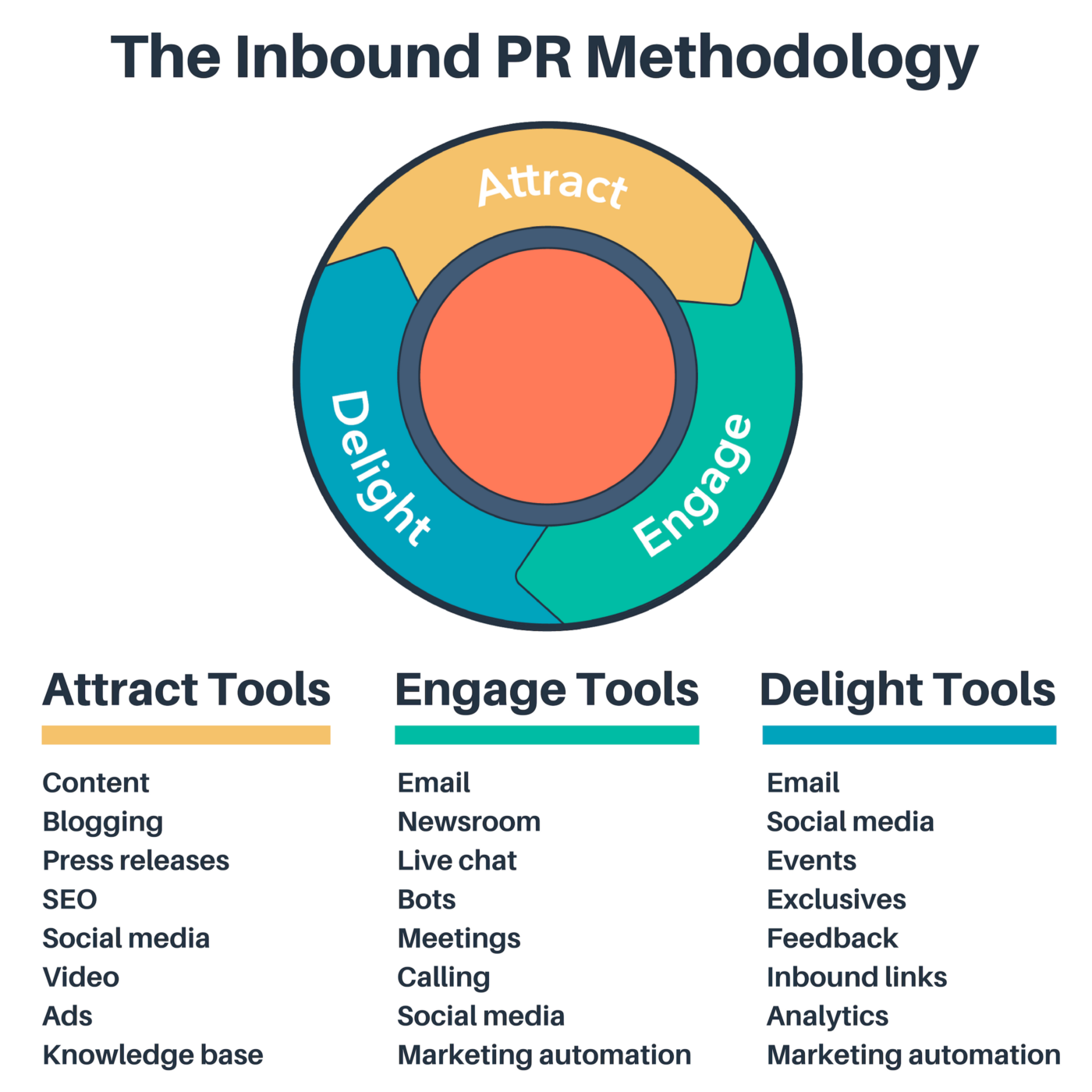
Here are the three stages of inbound marketing methodology that will transform strangers into prospects into promoters:
- Attracting press contacts
In the first stage of inbound PR, you want to pull in strangers, that being journalists, bloggers, influencers, and other thought leaders, towards your message. You do this by writing and publishing relevant, valuable content like blog posts, company stories, or press releases. Both your content as well as the platform you publish it on need to be optimized for search engines. Optimizing your content is crucial because once you pitch your story to journalists, they will most likely look you up online. If you don’t have a solid presence, be it through an online newsroom or on social media channels, they probably won’t consider you relevant and your chances of landing coverage decrease significantly.
- Engaging your audience
Once you’ve attracted the media, you want to entice them. You want to show that you are relevant and helpful. To do so, we recommend sharing insights and solutions to help them understand and/or overcome their struggles. This is the moment where personal connection matters the most, as it can help nurture and build relationships with the personas you are targeting. Because you’re dealing with someone who has already shown some interest in your brand, make sure you can provide added value to answer the questions or needs.
- Delighting your press network
The last stage in the inbound PR methodology is all about delighting your audience to ensure they come back to you in the future. To do so, you must provide a seamless experience for your audience. Let’s say you are targeting journalists, for example. One way to delight them is to make their jobs easier. You do this by making your information and assets publicly available and easy to find. Another way to make a journalist’s experience seamless is by being less invasive. Instead of sending out notifications for every press release you publish online, how about sending a biweekly or monthly newsletter? This way journalists are still receiving your news, but in a less intrusive way and with less frequency. You can also host digital events in your newsroom. This way if a journalist can travel for the actual event, they get minute-by-minute notes on the announcements being made at your event. Plus, they can always rewatch the event in your newsroom if needed. These are just some ways to make a journalist’s journey a great experience. If you make a good impression on them, you’ll increase your chances of them coming back to you for more stories in the future.
A while back, we sat with Iliyana Stareva, an ex-Hubspot PR leader, who took Hubspot’s ideology for marketing and applied it to public relations. To understand how to do media relations the inbound way, read our conversation here.
How to build your own inbound PR strategy

Ready to get started with your very own inbound PR strategy? Here are 6 steps that will help you get there:
1. Define your stakeholder personas
The most important and decisive part of developing an inbound PR strategy is defining who you’ll be speaking to. A persona is a semifictional representation of your ideal client or journalist. For PR purposes, we will use journalists or media contacts as personas. To create a profile for them, ask yourself the following questions:
- Who are the journalists, bloggers, or influencers that already have an interest in us?
- What does their day-to-day look like?
- How do they prefer to be reached?
- How do they research when picking and crafting a story?
- What challenges do they face?
Once you’ve defined your personas, you need to understand their decision-making process. This way, you will ensure that the content you are creating will answer the questions that may arise. There are three stages:
- awareness (of a problem): when a journalist realizes they need to write a story
- consideration (of a solution): when a journalist does research
- and decision (to work with you or someone else for a story): when media personas pick the brands/influencers to complete their story
Your job as a PR pro is to provide valuable content that will answer questions for every stage.
3. Create a content plan
After setting up profiles for your media personas and determining their decision-making process, it’s time to create a content plan. The goal of each piece of content – whether it’s a blog post, a video, or an e-book is to get your media persona further along their decision-making process.
4. Promote your content
Once you’ve carefully created and published your content in your owned media channels, it’s time to promote them to make sure it reaches the intended audience. Don't be afraid to repurpose your content and share it through different channels.
5. Nurture your leadsIf a media persona shows interest in your content, you want to continue to nurture them further through the decision-making journey. You can do this by designing personalized e-mail drip campaigns with relevant content. Tip: instead of bombarding your leads with tons of emails how about sharing a biweekly or monthly newsletter with the latest happenings in your company?
6. Measure resultsA strategy loses its power without the proper measurements in place. The magic of inbound PR is that you cannot only drive tangible results but also track them. PR measurement is a pretty vague subject. Below, we’ll share more on which KPIs you should be tracking and the tools that can help you do so.
How to measure if what you’re doing is working
No matter how hard you work or the impact you generate, there will always be someone at your company demanding to see reports and graphs of all sorts. And with good reason.
If you want to show the value of PR to your company, you have to back it up with data. Measuring your efforts can shine a light on the depth and reach of your impact. This leads to more resonant messages for your audience, more opportunities in your market and abroad, and hopefully, a bigger budget for your PR team.
Many of us would rather go to a cousin’s birthday and spend an afternoon discussing questionable politics with crazy uncle Bob than talk about PR measurement. Some PR pros call it an ‘unsolvable conundrum’ while others avoid the topic altogether. Figuring out a good way to measure success is one of the biggest challenges that PR pros face. But don’t let that idea intimidate you and get in the way of making strategic, informed decisions. PR measurements are a crucial part of your strategy.
How measurement helps you get a bigger budget
Imagine this. You walk into a meeting along with the marketing department. They’ve prepared a whole presentation to show the Chief Financial Officer exactly how many leads and how much revenue they’ve generated. They walk out of that meeting with bigger budgets, more staff, and a solid fist bump.
If you come to management asking for dollars in return for dollars, that’s very compelling. But if you come into meetings arguing that you create good stories, well, it’s unlikely that you will get you what you need.
“You need to be able to make the case for the value and the impact of your work. A way to do that is by bringing numbers to the table.” -Jeremy Perkins, Agility PR
But, of course, you don’t just measure the success (or failure) of your efforts for a bigger budget, and a happy boss. PR measurement also allows you to make more strategic decisions and ensure future efforts will have a higher chance of success. By setting a goal and a game plan from the start, you and your team will have a notion of what works and what doesn’t. Once the campaign is over, you can assess the outcomes and make the corrections for future PR actions. This way, even a failed campaign is useful: because its learnings are used to make future campaigns better.
Here's our honest take on how to set PR objectives and goals.
3 common misconceptions about PR measurements
One of the biggest challenges people in the industry face is proving bottom line results to executives. Surely, having to quantify the value that you bring to the table can be tricky. However, data is the most valuable asset when it comes to making decisions. Here are three common misconceptions about PR measurements:
-
PR pros are solely creative people
One common misconception is that PR pros are solely creative people. That’s why they tend to shy away from metrics. There’s even a popular theory that divides people into two categories, depending on which side of their brain is more dominant. Left-brained people tend to be more analytical while those with a dominant right brain are more creative. However, there is no evidence to support the claim that one has a more dominant side of the brain, as one has a dominant hand.
Surely, people might consider themselves more creative or story-driven than others, but stories stem from a place of interest and curiosity. Data and metrics can kick-start creativity. It’s a way to discover stories. If you want to resonate with any audience, you have to understand them. Storytelling can only be powerful if there is research to back it up. If you are just going to rely on creativity, you are missing out on an essential component of improvement: feedback and analysis. Without evaluating what made your campaign effective – or not, you miss the opportunity to learn and improve what you do in your following campaigns. Combining the power of storytelling with the guidance of data makes for better, more effective PR campaigns.
-
PR is not an exact science
While it’s harder to quantify variables like brand awareness compared to revenue or lead generation, for example, that doesn’t mean you shouldn’t be measuring the outcome of your campaign in the first place.
PR is not an exact science, but it’s not random either. If it was random, that means you could do just about anything; sometimes it would work and other times it wouldn’t. For example, let’s say you wanted to generate more business for Uber. So you go out on the street and throw spaghetti at people. According to the belief that PR is not an exact science, maybe this tactic would work, maybe it wouldn’t. That’s absurd, right?
There are certain messages or actions that work better for your audience, as there are others that can backfire and demolish your reputation very quickly. How can you tell those two apart? Through observation and measurement. Over time, you’ll start seeing trends that will give you insight into how a message will land.
-
Because reputation takes some time to build, you shouldn't bother trying to measure it
Reputation does take time to build. That’s because it is based on the beliefs or opinions that are created in each interaction between stakeholders and your brand. But that doesn't mean that we shouldn't try to understand if we're moving in the right direction.
Building a cathedral could take generations, but you'd still want to know if you were progressing. Otherwise, you'd never build a cathedral.

▲ Mick Stevens for the New Yorker
How to measure PR success
You probably guessed it – there is no right or wrong way to measure PR success. It all depends on the objectives you set, the market you are in, and ultimately, on your organization and product. To begin, the most important question to ask yourself is what problem are you trying to solve with these metrics? What are the business objectives that PR can help support? And once you determine that, how can you track them? “Measurements are not an end unto itself, but a step towards something,” says Jeremy.
Working with Key Performance Indicators (KPIs)
When it comes to scale-ups, there are certain metrics that begin to gain relevance as your company expands. As a scale-up, you’ve been in the industry long enough to understand what you do, who your audience is, and how you are different from your competitors. What follows this stage is raising awareness and making a place for yourself in the market.
Scale-ups should focus on competitive benchmarking. This gives you the insight to understand how you are doing against the established brands in the same space. Here are some of the KPIs you can measure:
- Brand awareness: How well-known your brand is to your target audience and how well it is recognized. Granted, it is a very vague metric, but the right quantitative measures will help determine if you’re going in the right direction. For instance, you can measure direct traffic to your website. This is the result of people typing out your URL, instead of finding you through social media or ads. This number can be used as a proxy for brand awareness.
- Media coverage: Staying on top of when and where your brand has been mentioned will help you protect its reputation. According to Muck Rack’s 2021 State of PR Measurement study, 94% of PR pros measure coverage or the number of stories placed. One way to do just that is by quantifying your media mentions. Here are some tools that can help you with that task.
- Share of voice: Share of voice allows you to understand your place in your market. Is your brand considered a leader in your industry? Does your brand come up in relevant conversations regarding the solutions you offer? This metric will illustrate how you stack up against your biggest competitors. Calculating share of voice would normally require you to quantify how many mentions you and your competitors have and the individual reach of these mentions. But before you get your calculator out, keep in mind that there are tons of tools that can do this for you. For starters, we recommend using Agility PR.
- Sentiment analysis: Sentiment analysis reveals how your brand is being represented to your audience. Is the media celebrating something the brand has done? Or is your brand being criticized? Measuring sentiment is a tricky task as there are many biases that can skew the data. A mix of tools and human analysis can give you a more well-rounded representation of how your brand is talked about in the media.
- Key message pull-through: According to Jeremy, one of the most important metrics that allow you to visualize the success of your PR efforts is key message pull-through. When your brand is being talked about in the media, are the right messages being transmitted? Are your key points showing up in the coverage? Your brand might get mentioned, but for the wrong reasons. For example, you might get negative press on your CEO or maybe a feature where the tone isn’t aligned with your core messaging.
Other KPIs to measure the success of your PR efforts:
- Number of pitches replied to
- Number of pitches sent
- SEO metrics (like Domain Authority, Page Authority, Global Rank, Spam score)
- Website conversions or form submissions
- Pitches opened or clicked
- Number of journalists that subscribed to your newsletter
- Article shares on social media
- Number of journalists that contacted you through your newsroom
Which metrics to avoid
If you want to know the impact you are generating, you have to ensure you’re looking in the right direction. Just take the drunkard’s search principle as a cautionary tale. Picture a drunk guy looking for his keys under a streetlight at night. A policeman approaches the man to ask him what he’s looking for. After a couple of minutes of searching, the policeman asks the man, ‘are you sure you lost them around here?’, to which the drunk replies ‘I lost them over there, but this is where the light is.’
Vanity metrics may feel good when you prove your worth to the rest of the team, but if you just focus on them, it will stall your brand’s growth. Measurement is very valuable unless you're busy measuring the wrong stuff or stuff that just doesn't connect to actually what outcome you're interested in.
One of these vanity metrics is media reach. It’s not entirely useless, but you should always take it with a grain of salt. Circulation and potential impressions can be a very broad and vague proxy for brand awareness. They tend to be dramatically overstated. For instance, I‘m subscribed to the Wired magazine newsletter, but that doesn’t mean I’ll read every article or every ad.
Another outdated metric is advertising equivalency value (AVE), which is used to measure the monetary value of media coverage by calculating its equivalent value in ad space. AVE was first used in the 1940s. It’s safe to say PR has evolved and so have its measurements. AVE has been debunked and rejected for about a decade. However, there are still some die-hard AVE believers. A study by Muck Rack reports that 19% of PR pros will use AVE as a metric in 2022. It’s usually someone higher up in management that still insists on seeing it. But as the saying goes, ‘science advances one funeral at a time’. As the generation of people who still embrace AVEs retire, the industry will naturally move on.
Here are the metrics that are gaining importance in the current media landscape.
Why PR isn’t optional
Breaking through a market is no easy feat, especially for startups and scale-ups that are competing against established corporations for some time in the spotlight. Standing out from the crowd takes time, effort, and of course, a budget. However, for many scale-ups, the importance of public relations is ´overlooked; it's usually the first “cost” to be cut.
In reality, public relations is the most cost-effective way to get your brand noticed and leave a lasting impression. If you research and play your cards right, chances are you’ll start connecting to new prospects, whether they be customers, investors, or the media. Over time, if you provide a seamless experience for each audience, you’ll harness trust which is the foundation for strong relationships.
This is important for every company, but it’s especially true for scale-ups. If you’re revolutionizing your industry and expanding to new markets, you need all of the resources you can get your hands on to get your message across. Now that you’ve read this guide, we hope you got a good overview of what it takes to succeed. We wish you the best of luck in your endeavors; knock ‘em dead!
Meet the PR pros
Meet the PR pros
At pr.co we believe in the collective power of our industry. We’re lucky enough to get to speak to some of the most seasoned PR pros out there, day in, day out. This guide is filled with their insight, being a testament to that shared knowledge. We wouldn’t have been able to create this guide without their help.
We’d like to thank everyone who was generous enough to share their time and insight with us. A special shout-out to:

Bianca Zwart is the founder of Black & White Communications, an Amsterdam-based PR agency that works with European fintech players such as bunq, BUX, and Tellow.

Matías Rodsevich is a PR specialist and Founder & CEO of PRLab. Matias has +10 years of PR & Marketing experience in B2B, B2C, technology, and product communications across corporate, startup, and agency environments. He now works as CEO & Founder of PRLab, an integrated marketing agency based in Amsterdam and, most recently, in Stockholm.

Fiola Foley is Director of Media Relations at Komoot, a navigation system that allows you to plan and experience authentic outdoor adventures. Fiola has worked for BMC Switzerland, Appway and Swarovski.

Christa Connell is Head of Public Relations at BUX, Europe’s fastest-growing neobroker. She is responsible for PR launch communications strategy for multi-country roll-outs across Europe, including the Netherlands, Germany, Austria, Belgium and France. 
Sarah Ninon Bertrand is a PR & Communications Manager at TicketSwap, a safe platform to buy and sell tickets for concerts, festivals, and other events. Besides Sarah's impressive career in communications, she also has 14+ years of experience in diverse domains such as innovation, arts and culture.

Jody Koehler is the co-founder of the Dutch PR agency Coopr. Jody and his team have helped brands in hypergrowth, like Groupon, Netflix, and Bolt, navigate the treacherous waters of media relations.

Jeremy Parkin heads up the media insights group at Agility PR Solutions where he helps PR professionals make sense of their media coverage and demonstrate their impact with tailor-made media insights reports.

